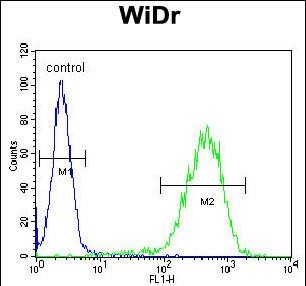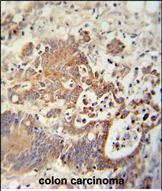


| WB | 1/1000 | Human,Mouse,Rat |
| IF | 咨询技术 | Human,Mouse,Rat |
| IHC | 1/100-1/500 | Human,Mouse,Rat |
| ICC | 技术咨询 | Human,Mouse,Rat |
| FCM | 1/10-1/50 | Human,Mouse,Rat |
| Elisa | 咨询技术 | Human,Mouse,Rat |
| Aliases | Coiled-coil-helix-coiled-coil-helix domain-containing protein 2, mitochondrial, Aging-associated gene 10 protein, HCV NS2 trans-regulated protein, NS2TP, CHCHD2, C7orf17 |
| Entrez GeneID | 51142 |
| WB Predicted band size | 15.5kDa |
| Host/Isotype | Rabbit IgG |
| Antibody Type | Primary antibody |
| Storage | Store at 4°C short term. Aliquot and store at -20°C long term. Avoid freeze/thaw cycles. |
| Species Reactivity | Human, Mouse |
| Immunogen | This CHCHD2 antibody is generated from rabbits immunized with a KLH conjugated synthetic peptide between 74-103 amino acids from the Central region of human CHCHD2. |
| Formulation | Purified antibody in PBS with 0.05% sodium azide. |
+ +
以下是关于CHCHD2抗体的3篇代表性文献摘要:
1. **文献名称**:*CHCHD2 mutations in autosomal dominant late-onset Parkinson’s disease*
**作者**:Funayama M. et al. (2015)
**摘要**:该研究首次发现CHCHD2基因突变与家族性帕金森病相关,利用特异性抗体检测患者细胞中CHCHD2蛋白表达下降,提示其异常可能导致线粒体功能障碍。
2. **文献名称**:*CHCHD2 regulates mitochondrial morphology by modulating OPA1 processing*
**作者**:Woo J.A. et al. (2017)
**摘要**:通过免疫沉淀和Western blot(使用CHCHD2抗体),揭示CHCHD2与线粒体融合蛋白OPA1的相互作用,证明其通过调控线粒体形态参与神经退行性病变。
3. **文献名称**:*Mitochondrial CHCHD2: A Potential Biomarker for Parkinson’s Disease*
**作者**:Liu Y. et al. (2020)
**摘要**:研究开发了高灵敏度CHCHD2抗体,发现帕金森病患者外周血线粒体中CHCHD2水平显著降低,提示其可作为早期诊断的生物标志物。
注:以上为文献核心内容概括,实际引用需核对原文。
CHCHD2 antibodies are immunological tools used to detect the Coiled-Coil-Helix-Coiled-Coil-Helix Domain-Containing Protein 2 (CHCHD2), a mitochondrial and nuclear protein implicated in cellular energy metabolism and stress responses. The CHCHD2 gene encodes a 151-amino-acid protein containing twin CHCH domains, which are critical for its structural stability and interaction with mitochondrial complexes. CHCHD2 localizes primarily to the mitochondrial intermembrane space, where it regulates mitochondrial cristae morphology, oxidative phosphorylation, and apoptosis. It also shuttles to the nucleus under stress conditions, modulating hypoxia-responsive pathways by interacting with transcription factors.
Mutations in CHCHD2 (e.g., T61I, R145Q) have been linked to autosomal dominant Parkinson’s disease and other neurodegenerative disorders, highlighting its role in mitochondrial dysfunction and neuronal survival. CHCHD2 antibodies, typically developed in rabbits or mice, enable the detection of endogenous CHCHD2 via techniques like Western blotting, immunohistochemistry, and immunofluorescence. These antibodies are essential for studying CHCHD2’s expression patterns, subcellular localization, and pathological mechanisms in diseases. Recent studies also explore CHCHD2’s potential as a biomarker or therapeutic target in neurodegeneration and cancer. Validation of antibody specificity is crucial, as cross-reactivity with homologous proteins like CHCHD10 may occur due to sequence similarities.
×